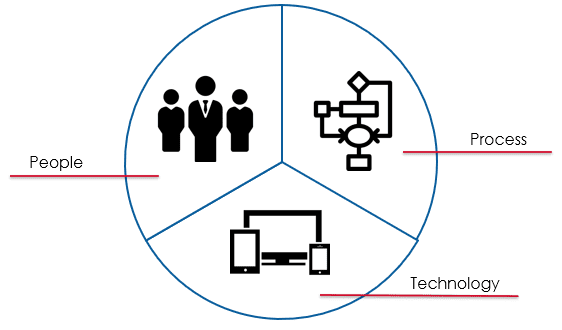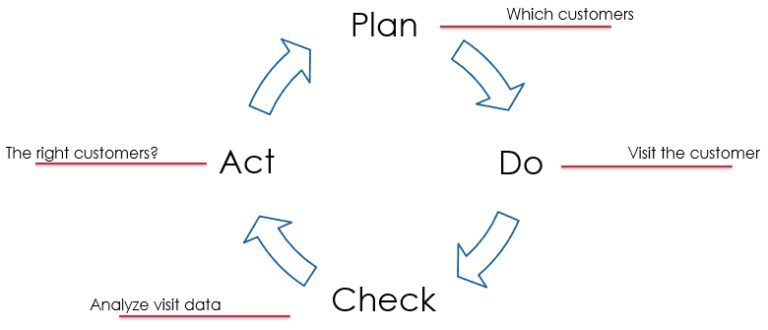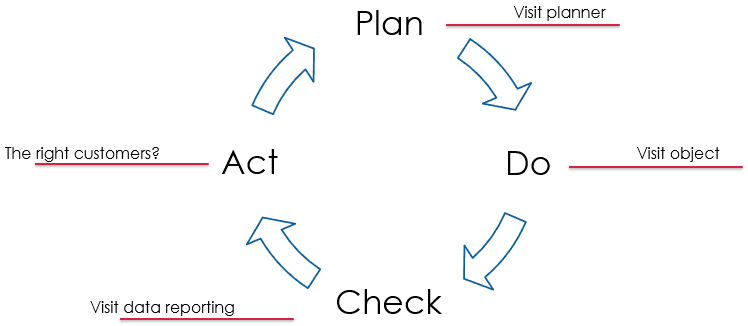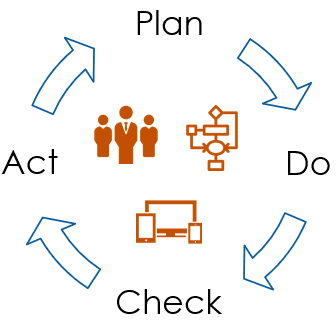Jasper Cremers
Read all my blogsYes, I know. The PDCA (Plan-Do-Check-Act) cycle was developed decades ago. So why write a blog about it? Because I still use this awesome concept pretty often when discussing business processes. In my experience, as a functional consultant, not all companies and employees have experience in the translation of business processes to the implementation of software (which is understandable). PDCA is pretty easy to understand and really helpful to use as a guideline. Let’s take visit management as an example.
People, Process & Technology
I want to start by looking at implementing software on a higher level. The three keys to successfully deploy IT applications are People, Process and Technology. And yes, when you Google “People, Process, Technology” you will probably get a million hits. But hey, not without good reason, right?

People: The users with their needs, behavior, roles and responsibilities
Process: The goals that we want to achieve and the business processes in place to reach those goals.
Technology: The means that support people and processes for reaching goals and the functionality to save and analyze information; in this case: SAP C4C.
These elements should be aligned; the processes and needed information should be clear to the user of the software. If the alignment is there, the implementation has better chances of being successful. Aligning these elements is of course not easy and one of the big challenges in an IT project.
Plan, Do, Check, Act
So how can these elements can be combined? Enter the PDCA cycle, which is an iterative four-step management method used for the control and continuous improvement of processes and products. I’m not going into details on PDCA (also a million Google hits probably). Most important is that this cycle can be adjusted to any process, e.g. logistics, financing or in this case; visit management.
With this PDCA cycle and ideally a clear definition of KPI’s, it is easier to prevent only focusing on planning and doing activities. This model will clarify what actions will be done by which people at what time. By checking and acting on People, Process and Technology, a continuous improvement can be reached.

Plan
Visits are expensive, so you want to focus on the right customers. Which prospects / customers are we going to visit? Who are we targeting? This information can be based on e.g. customer classification, turnover, size of a contract, etc.
The input can be based on financial/logistical applications, but also on other sources.
Functionality: Customer master data (employee responsible assignment, customer classification), reports on turnover, visit planner, visit frequencies, territory management, etc
Do
Preparing the visit and actually visit the customer. Visits can have different goals, which can lead to different visit types. During the customer visit, information can be shared or gathered. So business topics are discussed, questions are asked, notes are taken and a visit summary is promised.
Functionality: Turnover information, Microsoft Outlook integration, visits object, surveys, visit summaries, etc.
Check
How much time do we spend at a customer and what are we getting back?
 What did we plan and are we on schedule?
What did we plan and are we on schedule?
Functionality: Visit frequency, analytics (reports, dashboards & KPI)
Act
Maybe this is most important one: Are we visiting the right prospects / customers? Are we on schedule (according to the KPI’s) or do we need to adjust? Do we need to act on the analyzed information and do we need to adjust behavior?
Do we see an increasing line in customer satisfaction or turnover?
Functionality: Analytics (reports, dashboards & KPI)
This just a high level example, which can be discussed in more detail during appropriate workshops. PDCA and People Process Technology is not new (and maybe a bit of a cliché?). But as a functional consultant I often see companies that have challenges with the translation of business processes to the implementation of software. And this approach helped me multiple times.
So what about you? Are you using a similar approach? Or do you see room for improvement? Food for thought…




